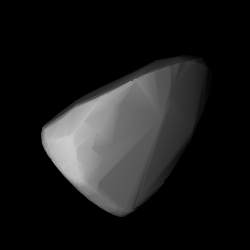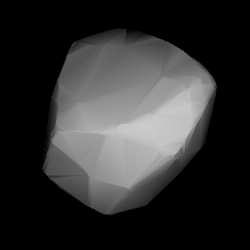Related Research Articles
Arago, provisional designation 1923 OT, is a dark asteroid from the outer regions of the asteroid belt, approximately 55 kilometers in diameter. It was discovered on 5 September 1923, by Russian astronomer Sergey Belyavsky at the Simeiz Observatory on the Crimean peninsula. The asteroid was named after French mathematician François Arago.
Pawlowia, provisional designation 1923 OX, is a background asteroid from the central regions of the asteroid belt, approximately 20 kilometers in diameter. It was discovered on 5 October 1923, by Soviet astronomer Vladimir Albitsky at the Simeiz Observatory on the Crimean peninsula. The asteroid was named after Russian physiologist and Nobelist Ivan Pavlov.

1039 Sonneberga, provisional designation 1924 TL, is a dark background asteroid, approximately 34 kilometers in diameter, located in the central region of the asteroid belt. It was discovered on 24 November 1924, by German astronomer Max Wolf at Heidelberg Observatory in southwest Germany. The asteroid was named for the German city of Sonneberg, where the Sonneberg Observatory is located.

1554 Yugoslavia, provisional designation 1940 RE, is a stony Eunomian asteroid from the middle region of the asteroid belt, approximately 16 kilometres (9.9 mi) in diameter. It was discovered by Serbian astronomer Milorad Protić at Belgrade Astronomical Observatory, Serbia, on 6 September 1940. It was named for the former country of Yugoslavia.

1118 Hanskya is a large background asteroid, approximately 77 kilometers in diameter, located in the outer regions of the asteroid belt. Discovered by Sergey Belyavsky and Nikolaj Ivanov in 1927, it was named after Russian astronomer Aleksey Hansky. The presumed dark C-type asteroid has a rotation period of 15.6 hours.

1132 Hollandia, provisional designation 1929 RB1, is a stony asteroid from the middle region of the asteroid belt, approximately 27 kilometers in diameter. It was discovered on 13 September 1929, by Dutch astronomer Hendrik van Gent at Leiden Southern Station, annex to the Johannesburg Observatory in South Africa. It was named for the region Holland in the Netherlands.
1136 Mercedes, provisional designation 1929 UA, is a background asteroid from the central regions of the asteroid belt, approximately 26 kilometers in diameter. It was discovered on 30 October 1929, by Catalan astronomer Josep Comas i Solà at the Fabra Observatory in Barcelona, Spain. The asteroid was named for the sister-in-law of the discoverer.

1457 Ankara, provisional designation 1937 PA, is a stony asteroid from the central region of the asteroid belt, approximately 18 kilometers in diameter. It was discovered on 3 August 1937, by German astronomer Karl Reinmuth at Heidelberg Observatory in southwest Germany, and later named for the Turkish capital city of Ankara.
2038 Bistro, provisional designation 1973 WF, is a stony asteroid from the inner regions of the asteroid belt, approximately 12 kilometers in diameter. The asteroid was discovered on 24 November 1973, by Swiss astronomer Paul Wild at the Zimmerwald Observatory near Bern, Switzerland. It was named for the Bistro restaurant.
1215 Boyer, provisional designation 1932 BA, is a stony Eunomian asteroid from the central region of the asteroid belt, approximately 20 kilometers in diameter. It was discovered by astronomer Alfred Schmitt in 1932, who named it after French astronomer and college Louis Boyer.
1240 Centenaria, provisional designation 1932 CD, is a background asteroid from the outer regions of the asteroid belt, approximately 60 kilometers in diameter. It was discovered on 5 February 1932, by astronomer Richard Schorr at the Bergedorf Observatory in Hamburg, Germany. The assumed C-type asteroid has a rotation period of 11.3 hours. It was named for the 100th anniversary of the discovering observatory.
1295 Deflotte, provisional designation 1933 WD, is a carbonaceous asteroid from the outer regions of the asteroid belt, approximately 48 kilometers in diameter. It was discovered on 25 November 1933, by French astronomer Louis Boyer at the Algiers Observatory in Algeria, North Africa. The asteroid was named after the discoverer's nephew.
1541 Estonia, provisional designation 1939 CK, is an asteroid from the central regions of the asteroid belt, approximately 21 kilometers in diameter. It was discovered on 12 February 1939, by astronomer Yrjö Väisälä at the Iso-Heikkilä Observatory near Turku, Finland. The asteroid was named after the Baltic country of Estonia.
1261 Legia, provisional designation 1933 FB, is a dark Themistian asteroid from the outer regions of the asteroid belt, approximately 32 kilometers in diameter. It was discovered on 23 March 1933, by astronomer Eugène Delporte at the Royal Observatory of Belgium in Uccle. The asteroid was named for the Belgian city of Liège (Luke).
1303 Luthera, provisional designation 1928 FP, is a dark asteroid and the parent body of the Luthera family, located in the outermost regions of the asteroid belt. It measures approximately 90 kilometers in diameter. The asteroid was discovered on 16 March 1928, by astronomer Friedrich Schwassmann at the Bergedorf Observatory in Hamburg, Germany, and later named after German astronomer Robert Luther.
2043 Ortutay, provisional designation 1936 TH, is a dark asteroid from the outer regions of the asteroid belt, approximately 45 kilometers in diameter. The asteroid was discovered by Hungarian astronomer György Kulin at the Konkoly Observatory, Budapest, on 12 November 1936. It was named after Hungarian ethnographer Gyula Ortutay.
1258 Sicilia, provisional designation 1932 PG, is a dark background asteroid from the outer regions of the asteroid belt, approximately 44 kilometers in diameter. It was discovered on 8 August 1932, by astronomer Karl Reinmuth at the Heidelberg-Königstuhl State Observatory in southwest Germany. The asteroid was named after the Italian island of Sicily.

2120 Tyumenia is a dark background asteroid, approximately 45 kilometers in diameter, located in the outer regions of the asteroid belt. It was discovered on 9 September 1967, by Soviet astronomer Tamara Smirnova at the Crimean Astrophysical Observatory in Nauchnyj, on the Crimean peninsula. The asteroid was named for the now Russian district of Tyumen Oblast in Western Siberia.
1608 Muñoz, provisional designation 1951 RZ, is a Flora asteroid from the inner regions of the asteroid belt, approximately 6.5 kilometers in diameter. It was discovered on 1 September 1951, by Argentine astronomer Miguel Itzigsohn at the La Plata Astronomical Observatory, in La Plata, Argentina. The S-type asteroid has a rotation period of 5.3 hours. It was named after F. A. Muñoz, one of the assistant astronomers at the discovering observatory.
(7563) 1988 BC is a background asteroid from the central region of the asteroid belt, approximately 16 kilometers in diameter. It was discovered on 16 January 1988, by Japanese amateur astronomer Takuo Kojima at the YGCO Chiyoda Station in the Kantō region of Japan. The asteroid has a rotation period of 6.5 hours.
References
- 1 2 3 4 "JPL Small-Body Database Browser: 1319 Disa (1934 FO)" (2017-06-05 last obs.). Jet Propulsion Laboratory . Retrieved 25 July 2017.
- ↑ "disa" . Oxford English Dictionary (Online ed.). Oxford University Press.(Subscription or participating institution membership required.)
- 1 2 3 4 Schmadel, Lutz D. (2007). "(1319) Disa". Dictionary of Minor Planet Names – (1319) Disa. Springer Berlin Heidelberg. p. 108. doi:10.1007/978-3-540-29925-7_1320. ISBN 978-3-540-00238-3.
- 1 2 3 4 5 6 "LCDB Data for (1319) Disa". Asteroid Lightcurve Database (LCDB). Retrieved 16 January 2017.
- 1 2 3 Masiero, Joseph R.; Mainzer, A. K.; Grav, T.; Bauer, J. M.; Cutri, R. M.; Nugent, C.; et al. (November 2012). "Preliminary Analysis of WISE/NEOWISE 3-Band Cryogenic and Post-cryogenic Observations of Main Belt Asteroids". The Astrophysical Journal Letters. 759 (1): 5. arXiv: 1209.5794 . Bibcode:2012ApJ...759L...8M. doi:10.1088/2041-8205/759/1/L8 . Retrieved 16 January 2017.
- 1 2 3 4 Usui, Fumihiko; Kuroda, Daisuke; Müller, Thomas G.; Hasegawa, Sunao; Ishiguro, Masateru; Ootsubo, Takafumi; et al. (October 2011). "Asteroid Catalog Using Akari: AKARI/IRC Mid-Infrared Asteroid Survey". Publications of the Astronomical Society of Japan. 63 (5): 1117–1138. Bibcode:2011PASJ...63.1117U. doi:10.1093/pasj/63.5.1117. (online, AcuA catalog p. 153)
- 1 2 Masiero, Joseph R.; Grav, T.; Mainzer, A. K.; Nugent, C. R.; Bauer, J. M.; Stevenson, R.; et al. (August 2014). "Main-belt Asteroids with WISE/NEOWISE: Near-infrared Albedos". The Astrophysical Journal. 791 (2): 11. arXiv: 1406.6645 . Bibcode:2014ApJ...791..121M. doi:10.1088/0004-637X/791/2/121 . Retrieved 16 January 2017.
- 1 2 3 4 5 Mainzer, A.; Grav, T.; Masiero, J.; Hand, E.; Bauer, J.; Tholen, D.; et al. (November 2011). "NEOWISE Studies of Spectrophotometrically Classified Asteroids: Preliminary Results". The Astrophysical Journal. 741 (2): 25. arXiv: 1109.6407 . Bibcode:2011ApJ...741...90M. doi:10.1088/0004-637X/741/2/90.
- 1 2 Warner, Brian D. (December 2006). "Asteroid lightcurve analysis at the Palmer Divide Observatory - February - March 2006". The Minor Planet Bulletin. 33 (4): 82–84. Bibcode:2006MPBu...33...82W. ISSN 1052-8091 . Retrieved 16 January 2017.
- 1 2 Behrend, Raoul. "Asteroids and comets rotation curves – (1319) Disa". Geneva Observatory . Retrieved 16 January 2017.
- 1 2 3 Waszczak, Adam; Chang, Chan-Kao; Ofek, Eran O.; Laher, Russ; Masci, Frank; Levitan, David; et al. (September 2015). "Asteroid Light Curves from the Palomar Transient Factory Survey: Rotation Periods and Phase Functions from Sparse Photometry". The Astronomical Journal. 150 (3): 35. arXiv: 1504.04041 . Bibcode:2015AJ....150...75W. doi:10.1088/0004-6256/150/3/75 . Retrieved 16 January 2017.
- 1 2 "1319 Disa (1934 FO)". Minor Planet Center. Retrieved 16 January 2017.